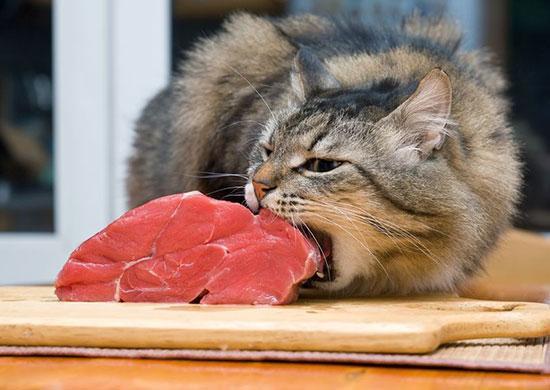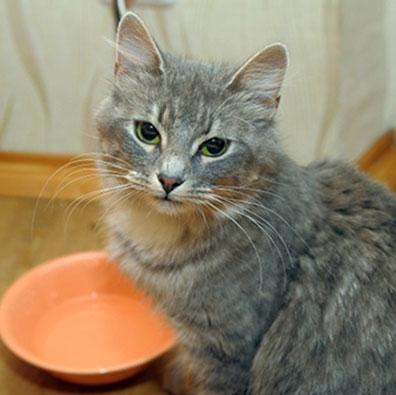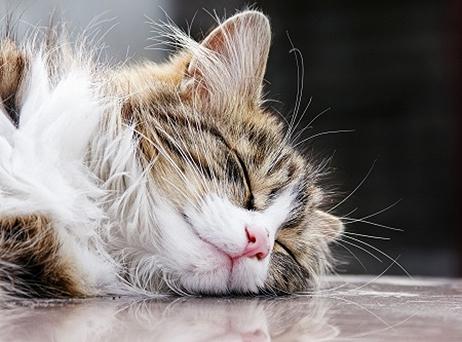This content is archived from the Feline Nutrition Foundation
Phosphorus Can Be Key for Cat Kidneys
- Updated: Tuesday, April 30, 2019 02:06 PM
- Published: Sunday, September 22, 2013 06:11 PM
- Written by Lyn Thomson, BVSc DipHom
 I have a cat with kidney disease and have heard that reducing phosphorus intake is important for cats with kidney problems. Is it safe to feed a cat with chronic kidney disease a raw food diet? Doesn't it have too much phosphorus? My cat hates the prescription diet and I am looking for an alternative for him.
I have a cat with kidney disease and have heard that reducing phosphorus intake is important for cats with kidney problems. Is it safe to feed a cat with chronic kidney disease a raw food diet? Doesn't it have too much phosphorus? My cat hates the prescription diet and I am looking for an alternative for him.
Dietary management is important for cats with kidney disease. There are three main aspects to this. Number one is water intake. Cats with chronic kidney disease are more likely to become dehydrated due to the reduced ability of the kidneys to conserve water by concentrating urine. Maintaining a good fluid intake is very important. As cats generally gain much of their water from their food, cats with chronic renal disease should, whenever possible, be fed wet foods rather than dry, grain-based foods.
Number two is protein content. An ideal diet for a cat with renal disease should have a highly digestible, bio-appropriate protein content, such as rabbit and poultry. Many of the toxic products that accumulate in the blood in renal failure are a result of protein breakdown. Clinically, we find that renal cats eating a raw food diet do well on highly digestible proteins like rabbit, chicken, hare and possum. Too little protein in the diet can lead to excessive weight loss that can be extremely detrimental to a cat's general health. Cats find low-protein diets less palatable. Moving to a raw, high-quality protein diet from a renal prescription diet often leads to improved appetite.
Number three is low phosphate content. Phosphorous is a mineral essential to good health. The healthy body is good at regulating phosphorous levels by removing excess phosphorous via the kidneys. The kidneys of a CKD cat can no longer excrete excess phosphorous. The majority of CKD cats will eventually have high levels of phosphorous in their blood, called hyperphosphataemia. Hyperphosphataemia can present as a lack of appetite, lack of co-ordination, weakness and twitching. Often the head is held down as though the cat is too weak to hold his head up.
 Restricting the phosphate content of the diet appears to be quite beneficial in protecting the kidneys from further damage in cats with chronic renal failure. Phosphate can be restricted by removing high phosphate foods from the diet and using a phosphate binder if the blood phosphate concentrations are high despite being on a lowered phosphate diet.
Restricting the phosphate content of the diet appears to be quite beneficial in protecting the kidneys from further damage in cats with chronic renal failure. Phosphate can be restricted by removing high phosphate foods from the diet and using a phosphate binder if the blood phosphate concentrations are high despite being on a lowered phosphate diet.
High phosphate foods are hard to define for an obligate carnivore. Meat is seen as being high in phosphorous, but again, this is not high for an obligate carnivore, but challenging for an obligate carnivore in renal failure. We opt to feed raw meaty bones with the bone ground into the mix. The ground-in bone helps to balance the phosphorous levels as what really matters is the calcium:phosphorous ratio. We find that our CKD patients do well on a raw cat food diet, as it supplies calcium and phosphorous in perfect combination. We add phosphate binders if we find their blood phosphate levels are creeping up. Phosphate binders should be used under instruction from your veterinary surgeon.
Prescription renal diets are generally formulated as follows:
Reduced levels of protein, reduced phosphorous, reduced sodium, increased levels of omega-3 fatty acids, increased levels of B-vits and added antioxidants. Debate has raged over the reduced levels of protein for an obligate carnivore. As a practice advocating raw food for cats, we have always opted for high-quality, easily-digested protein over reducing protein levels. This is achieved using bio-appropriate protein sources, e.g. rabbit, hare or poultry, rather than plant-based proteins or proteins that are challenging to digest, such as chicken meal, fish meal or corn gluten meal.¹
Recognising that raw cat food diets are not high in protein is important. They are appropriate protein levels for an obligate carnivore. No studies have conclusively demonstrated that severe restriction of protein alone will prevent worsening of renal failure. All of the studies have restricted the protein and lowered the phosphorous levels and restricted salt.² It is now thought that lowering the serum phosphate concentration is much more important in management of renal failure in cats, due to their nature as obligate carnivores and their high requirement for protein. The renal diets studied have also all been supplemented with potassium, B-vitamins and omega-3 fatty acids.³
 So, how do we achieve this with raw food for cats? Interestingly, a natural diet is almost perfect for cats in renal failure. It is highly digestible, with good-quality protein and lots of natural essential fatty acids from wild caught prey. It's high in B-vitamins due to the organs in the diet and has low phosphate levels due to the raw meaty bones being naturally low in phosphates compared to a cereal-based diet. If you are feeding your cat farmed meats, it may be a good idea to add some omega-3 supplements, as farmed meat is lower in this essential fatty acid.
So, how do we achieve this with raw food for cats? Interestingly, a natural diet is almost perfect for cats in renal failure. It is highly digestible, with good-quality protein and lots of natural essential fatty acids from wild caught prey. It's high in B-vitamins due to the organs in the diet and has low phosphate levels due to the raw meaty bones being naturally low in phosphates compared to a cereal-based diet. If you are feeding your cat farmed meats, it may be a good idea to add some omega-3 supplements, as farmed meat is lower in this essential fatty acid.
Additional Reading
A Diet for Your Cat's Urinary and Kidney Health
Don't Let Calcium/Phosphorous Ratios Scare You
A raw cat food diet is ideal and fits the requirements of an obligate carnivore. If we consider that the majority of cats are in a state of chronic dehydration due to dry commercial diets, it is not surprising that older cats have a tendency to renal failure. Getting these renal cats onto high-moisture raw food can be a real turning point for them.
Note: Feline Nutrition provides feline health and nutrition information as a public service. Diagnosis and treatment of specific conditions should always be in consultation with your own veterinarian. Feline Nutrition disclaims all warranties and liability related to the veterinary advice and information provided on this site.
Dr. Lyn Thomson trained at the University of Bristol in England and is studying with the Australasian College of Nutritional and Environmental Medicine. A dedicated and experienced advocate of bio-appropriate nutrition, Lyn practices in Auckland, New Zealand. HerRaw Essentialsstores have grown to seven retail locations, providing a variety of raw diet products for cats and dogs.
1. M Funaba, Y Oka, S Kobayashi, M Kaneko, H Yamamoto, K Namikawa, T Iriki, Y Hatano and M Abe, "Evaluation of Meat Meal, Chicken Meal and Corn Gluten Meal as Dietary Sources of Protein in Dry Cat Food," The Canadian Journal of Veterinary Research vol. 69, 2005, 299-304.
2. KC Bovée, DVM, MMedSc, "Mythology of Protein Restriction for Dogs with Reduced Renal Function," Supplement to Compendium on Continuing Education for the Practicing Veterinarianvol. 21, no. 11(K), Nov 1999, 15-20.
3. SA Brown, VMD, PhD, M Rickertsen, BS, S Sheldon, DVM, "Effects of an Intestinal Phosphorus Binder on Serum Phosphorus and Parathyroid Hormone Concentration in Cats With Reduced Renal Function," International Journal of Applied Research in Veterinary Medicine vol. 6, no. 3, 2008, 155-160.




